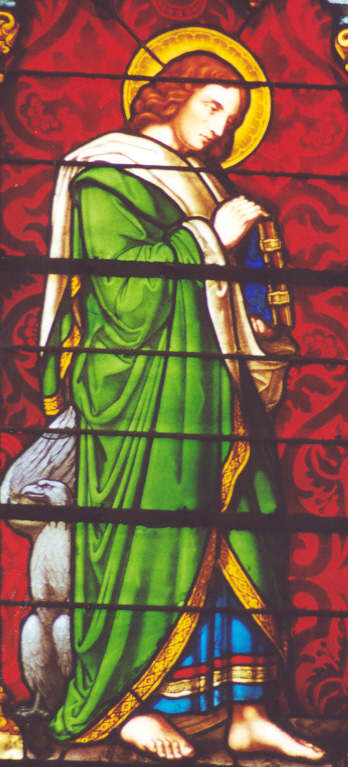
John 20:01-09
Know and Believe
by Rev. James C. Hudgins
Reprinted with permission of "The Arlington Catholic
Herald"
Home Page
To Sunday Gospel Reflections Index
John wrote to show that Christ was
the Messiah, the Divine Son of God.

On the first day of the week, Mary of Magdala came to the tomb early in the morning, while it was still dark, and saw the stone removed from the tomb. So she ran and went to Simon Peter and to the other disciple whom Jesus loved, and told them, "They have taken the Lord from the tomb, and we don't know where they put him." So Peter and the other disciple went out and came to the tomb. They both ran, but the other disciple ran faster than Peter and arrived at the tomb first; he bent down and saw the burial cloths there, but did not go in. When Simon Peter arrived after him, he went into the tomb and saw the burial cloths there, and the cloth that had covered his head, not with the burial cloths but rolled up in a separate place. Then the other disciple also went in, the one who had arrived at the tomb first, and he saw and believed. For they did not yet understand the Scripture that he had to rise from the dead.
Grave robbery was a lucrative crime in the ancient world, but it was also perilous and complicated. To carry out the task, one needed at least 10 men working together as an efficient, well-trained team. Stone masons, torchbearers, water-bearers and many strong backs were needed to dislodge a stone as large as six feet in diameter, weighing as much as two tons, and anchored in place by a gap carved into the ground. All this had to be done quickly and silently, under cover of darkness in the dead of night, because by an edict of Caesar Augustus, the penalty for grave robbery was death.
A grave robber was never quite sure what treasures he might find in a tomb, but one thing was certain; the dead body itself had no value. The only reason a cadaver might be stolen from a tomb was for the value of the burial cloths that wrapped it, but no one intent on stealing a body would ever expend the time needed to unwrap it first. So, when the Gospel this week tells us how Mary Magdalene and the apostles came to the tomb that first Easter Sunday morning, and found the burial cloths present but the body of Jesus missing, they knew something very mysterious had just happened. Just how mysterious, they had not yet begun to fathom. From that moment onward, the world would never be the same again.
When Jesus died on the cross, his disciples thought it was the death of all hope. The man they had sworn was the promised Messiah was sealed in a tomb. The Son of God was a stone-cold corpse. Jesus’ enemies, by contrast, thought they had finally and definitively won the day. Certainly now, the troublesome rabbi from Galilee would never be heard from again. But neither Jesus’ friends nor his adversaries could have possibly imagined what would happen next. On the first day of the week, in the silent hours before dawn, Jesus Christ rose triumphantly from the dead.
Since the time of Adam and Eve, the wages of sin had been death, and the darkness of the tomb held claim to every human soul. The inevitability of death and decay cast a grim pall across every culture in human history. William Shakespeare once called death “undiscovered country, from whose bourne no traveler ever returns.” And although some people report near-death experiences, or tell stories of a glimpse of what might lie beyond, no one had ever gone there and come back again — until now. On that first Easter Sunday, God did something entirely new. The God who became man had taken the sin of the world onto himself, had broken the grip of death, and had reversed the ancient curse.
St. Augustine once called Jesus’ resurrection “God's supreme and wholly marvelous work.” Since it is God himself who came back from the grave, his resurrection is nothing less than the bedrock of Christian hope and the source of all joy. Conquering the cold finality of death, Jesus showed the supreme extent of God's power, wisdom and love. When things could not possibly get any worse, when man had sinned as badly as anyone ever could, when the last flicker of hope had died, when it appeared that darkness and evil had won the final victory — that was the very moment in which goodness won the fight. Easter Sunday proves that what is good cannot be destroyed, that truth cannot be vanquished and death itself is now the gateway to life.
Now, the task at hand for us is to choose to believe. Believe in this victory, and you’ll always see the light, no matter how dark it gets. Believe in this victory, and even death itself will hold no threat over you. It will become a gateway to your true home. Mother Teresa of Kolkata used to say, “Don’t let any hardship in your life cause you to forget the joy that is Jesus Christ rose from the dead.” Know that and believe. Believe, and act. Amen, and alleluia.